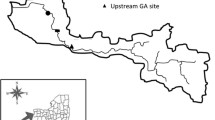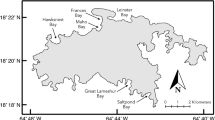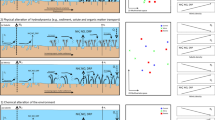Abstract
Studies examining the impacts of introduced species on food webs often focus on the top-down effects of introduced predators. However, marine and estuarine systems have been invaded by plants that have the potential to alter carbon and nitrogen sources available to consumers. In San Francisco Bay, California, USA, hybridized cordgrass Spartina alterniflora × foliosa is adding C4 carbon biomass to this system. We used natural abundances of stable isotopes of carbon and nitrogen to examine whether infaunal and epifaunal food webs reflected the large detrital input from hybrid Spartina. We compared stable isotope signatures among macrofaunal invertebrate consumers collected in hybrid Spartina, native S. foliosa, or unvegetated mudflats. We found no additional shift towards hybrid Spartina in hybrid areas. Structural changes brought about by an invasive ecosystem engineer, specifically increased biomass and detrital inputs, do not necessarily result in its increased incorporation into the food web.




Similar content being viewed by others
References
Ayres DR, Smith DL, Zaremba K, Klohr S, Strong DR (2004) Spread of exotic cordgrasses and hybrids (Spartina spp.) in the tidal marshes of San Francisco Bay. Biol Inv 6:221–231. doi:10.1023/B:BINV.0000022140.07404.b7
Bailey JK, Schweitzer JA, Whitham TG (2001) Salt cedar negatively affects biodiversity of aquatic macroinvertebrates. Wetlands 21:442–447. doi:10.1672/0277-5212(2001)021[0442:SCNABO]2.0.CO;2
Bildstein KL, Bancroft G, Dugan PJ, Gordon DH, Erwin RM, Nol E et al (1991) Approaches to conservation of coastal wetlands in the western hemisphere. Wilson Bull 103:218–254
Bosley KL, Wainwright SC (1999) Effects of preservatives and acidification on the stable isotope ratios (15N:14N, 13C:12C) of two marine animals. Can J Fish Aquat Sci 56:2181–2185
Bossard CC, Randall JM, Hoshovsky MC (2000) Invasive plants of california’s wildlands. University of California Press, Berkeley CA, USA
Brusati ED, Grosholz ED (2006) Native and introduced ecosystem engineers produce contrasting effects on estuarine infaunal communities. Biol Inv 8:683–695. doi:10.1007/s10530-005-2889-y
Brusati ED, Grosholz ED (2007) Effect of native and invasive cordgrass on Macoma petalum density, growth, and isotopic signatures. Estuar Coast Shelf Sci 71:517–522. doi:10.1016/j.ecss.2006.08.026
Byers JE (2000) Competition between two estuarine snails: implications for invasions of exotic species. Ecology 81:1225–1239
Cloern JE, Canuel EA, Harris D (2002) Stable carbon and nitrogen isotope composition of aquatic and terrestrial plants of the San Francisco Bay estuarine system. Limnol Oceanogr 47:713–729
Creach V, Schricke MT, Bertru G, Mariotti A (1997) Stable isotopes and gut analyses to determine feeding relationships in saltmarsh macroconsumers. Estuar Coast Shelf Sci 44:599–611. doi:10.1006/ecss.1996.0147
Currin CA, Newell SY, Pearl HW (1995) The role of standing dead Spartina alterniflora and benthic macroalgae in salt marsh food web: considerations based on multiple stable isotope analysis. Mar Ecol Prog Ser 121:99–116. doi:10.3354/meps121099
Deegan LA, Garritt RH (1997) Evidence for spatial variability in estuarine food webs. Mar Ecol Prog Ser 147:31–47. doi:10.3354/meps147031
Gratton C, Denno RF (2006) Arthropod food web restoration following removal of an invasive plant. Ecol Appl 16:622–631. doi:10.1890/1051-0761(2006)016[0622:AFWRFR]2.0.CO;2
Grosholz ED, Ruiz GM, Dean CA, Shirley KA, Maron JL, Connors PG (2000) The impacts of a nonindigenous marine predator in a California bay. Ecology 81:1206–1221
Hsieh H-L, Chen C-P, Chen Y-G, Yang H-H (2002) Diversity of benthic organic matter flows through polychaetes and crabs in a mangrove estuary: d13C and d34S signals. Mar Ecol Prog Ser 227:145–155. doi:10.3354/meps227145
Josselyn M (1983) The ecology of San Francisco Bay tidal marshes: a community profile. Report No. FWS/OBS-83/23. US Fish and Wildlife Service Division of Biological Services, Washington, DC
Kimmerer WJ, Gartside E, Orsi JJ (1994) Predation by and introduced clam as the likely cause of substantial declines in zooplankton of San Francisco Bay. Mar Ecol Prog Ser 113:81–93. doi:10.3354/meps113081
Kwak TJ, Zedler JB (1997) Food web analysis of southern California coastal wetlands using multiple stable isotopes. Oecologia 110:262–277. doi:10.1007/s004420050159
Langdon CJ, Newell RIE (1990) Utilization of detritus and bacteria as food sources by two bivalve suspension-feeders, the oyster Crassostrea virginica and the mussel Geukensia demissa. Mar Ecol Prog Ser 58:299–310. doi:10.3354/meps058299
Levin LA, Neira C, Grosholz ED (2006) Invasive cordgrass modifies wetland trophic function. Ecology 87:419–432. doi:10.1890/04-1752
Levine JM, Vila M, D’Antonio C, Dukes JS, Grigulis K, Lavorel S (2003) Mechanisms underlying the impacts of exotic plant invasions. Proc R Soc Lond 270:775–781. doi:10.1098/rspb.2003.2327
Neira C, Levin L, Grosholz E (2005) Alteration of wetland ecosystems in San Francisco Bay by Spartina hybrid invasion. Mar Ecol Prog Ser 292:111–126. doi:10.3354/meps292111
Neira C, Grosholz ED, Levin LA, Blake R (2006) Mechanisms generating modification of benthos following tidal flat invasion by a Spartina hybrid. Ecol Appl 16:1391–1404. doi:10.1890/1051-0761(2006)016[1391:MGMOBF]2.0.CO;2
Page HM (1997) Importance of vascular plant and algal production to macro-invertebrate consumers in a southern California salt marsh. Estuar Coast Shelf Sci 45:823–834. doi:10.1006/ecss.1997.0254
Peterson BJ (1999) Stable isotopes as tracers of organic matter input and transfer in benthic food webs: a review. Acta Oecol 20:479–487. doi:10.1016/S1146-609X(99)00120-4
Peterson BJ, Howarth RW, Garritt RH (1986) Sulfur and carbon isotopes as tracers of salt-marsh organic matter flow. Ecology 67:865–874. doi:10.2307/1939809
Ruckelshaus MH, Wissmar RC, Simenstad CA (1993) The importance of autotroph distribution to mussel growth in a well-mixed, temperate estuary. Estuaries 16:898–912. doi:10.2307/1352448
SPSS (1998) Systat Version 9.0 for Windows. SPSS, Inc., Chicago, IL
VanderZanden MJ, Casselman JM, Rasmussen JB (1999) Stable isotope evidence for the food web consequences of species invasions in lakes. Nature 401:464–467. doi:10.1038/46762
Wainwright SC, Weinstein MP, Able KW, Currin CA (2000) Relative importance of benthic microalgae, phytoplankton, and the detritus of smooth cordgrass, Spartina alterniflora, and the common reed Phragmites australis to brackish-marsh food webs. Mar Ecol Prog Ser 200:77–91. doi:10.3354/meps200077
Weis JS, Weis P (2003) Is the invasion of the common reed, Phragmites australis, into tidal marshes of the eastern US an ecological disaster? Mar Pollut Bull 46:816–820. doi:10.1016/S0025-326X(03)00036-5
Whitlatch RB, Obreski S (1980) Feeding selectivity and coexistence in two deposit-feeding gastropods. Mar Biol (Berl) 58:219–225. doi:10.1007/BF00391879
Acknowledgments
Funding was provided by the Canon National Parks Science Scholars Program (E.B.), University of California Coastal Environmental Quality Initiative (E.B.), UC-Davis Public Service Research Group (E.B.), Bodega Marine Laboratory, Sigma Xi (E.B.), a Jastro Shields grant (E.B.), and the NSF Biocomplexity Program (DEB-0083583) (E.G.). We thank D. Ayres for cordgrass genetic analysis, and R. Blake, N. Rayl, S. Norton, and T. Dillon, for field and lab assistance. Point Reyes National Seashore (permit PORE-2001-SCI-0026), Gulf of the Farallones National Marine Sanctuary (permit GFNMS-2001–004), Cypress Grove Preserve, China Camp State Park, and East Bay Regional Parks provided access to study sites. We thank Grosholz lab staff, especially C. Tyler, as well as J. Stachowicz, D. Strong, and other reviewers for their comments and discussion.
Author information
Authors and Affiliations
Corresponding author
Rights and permissions
About this article
Cite this article
Brusati, E.D., Grosholz, E.D. Does invasion of hybrid cordgrass change estuarine food webs?. Biol Invasions 11, 917–926 (2009). https://doi.org/10.1007/s10530-008-9304-4
Received:
Accepted:
Published:
Issue Date:
DOI: https://doi.org/10.1007/s10530-008-9304-4




